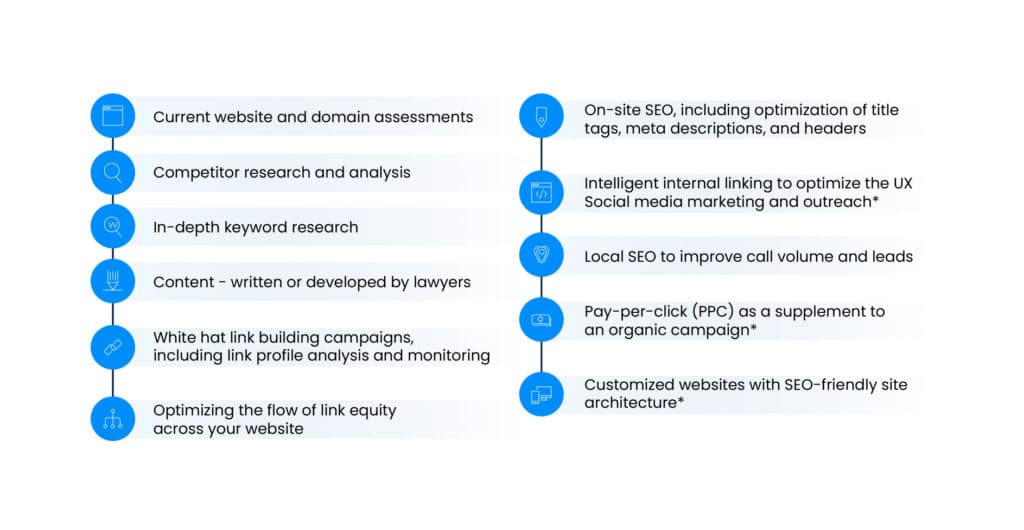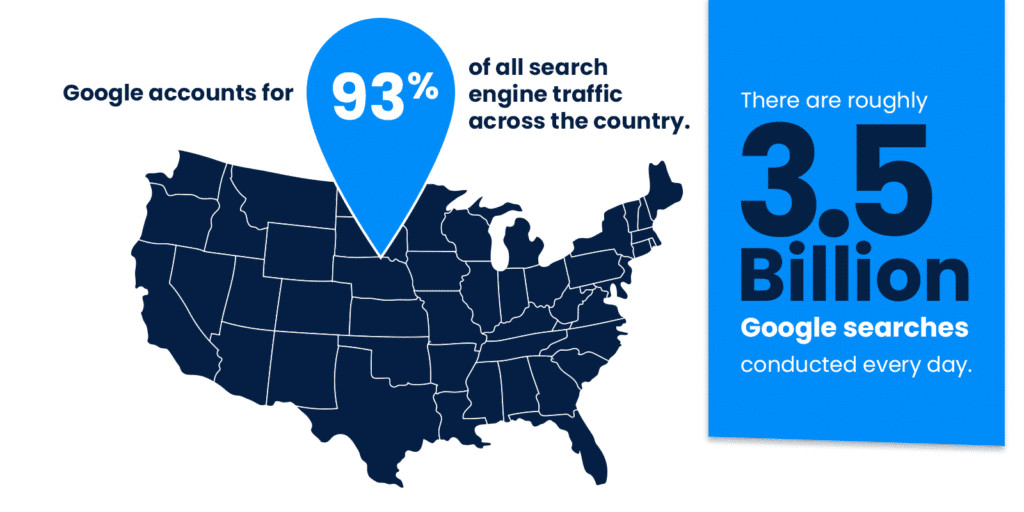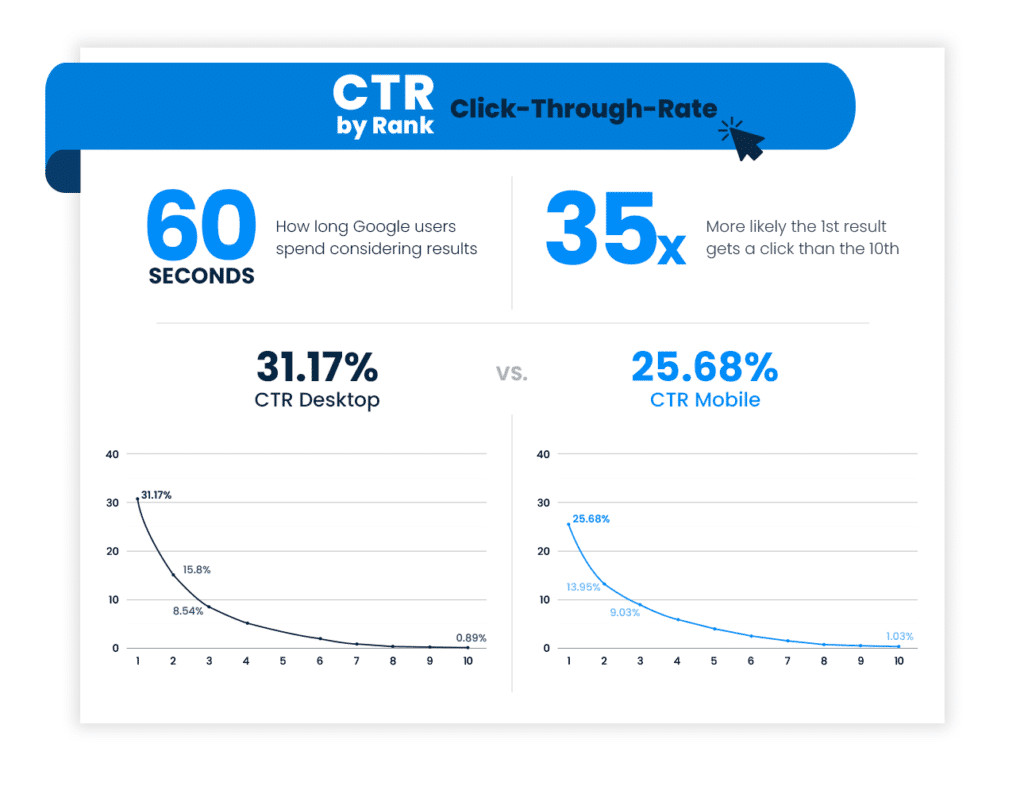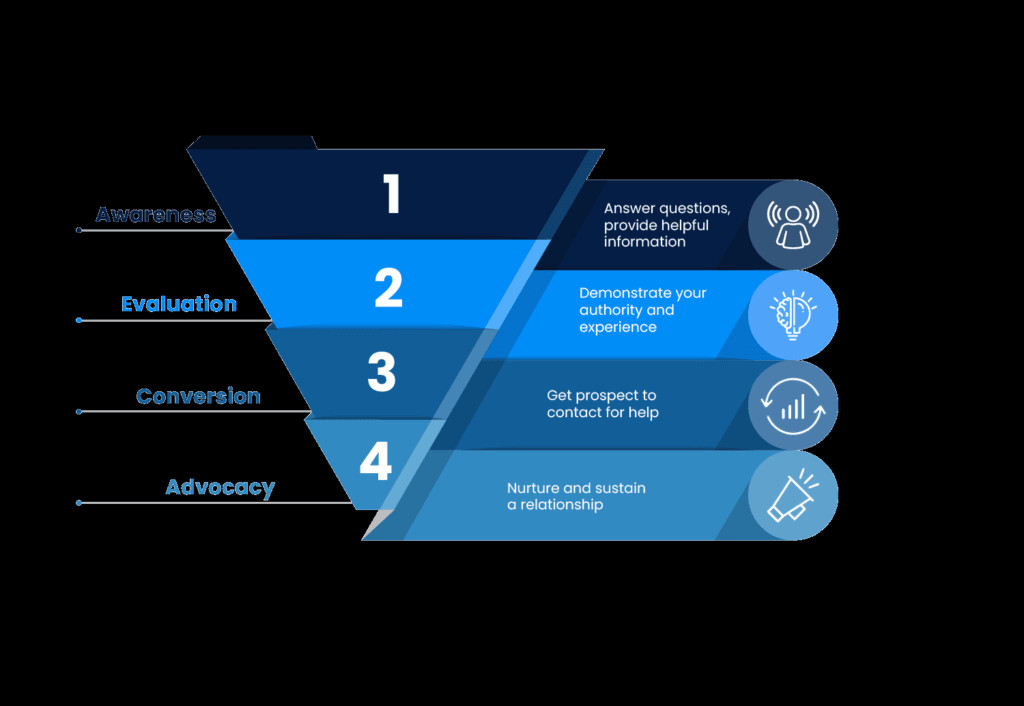If you aim to dominate Google search results and secure top-tier visibility that converts into client traffic, then mastering lawyer SEO is not just beneficial—it’s essential. While becoming a legal digital marketing guru isn’t mandatory, grasping the fundamentals of search engine optimization (SEO) and crafting a robust SEO strategy tailored for your law firm is crucial for success.
LawRank’s SEO Guide for Lawyers is designed to equip you with everything you need to elevate your law firm’s ranking on search engines like Google, achieving unparalleled SEO success. This guide provides a roadmap to understanding and implementing the best SEO practices in the legal field.
 SEO Basics
SEO Basics
After exploring this guide, you will gain actionable insights into the most effective legal SEO strategies and tactics, including:
- Understanding Key Ranking Factors: Learn what Google prioritizes when ranking websites in organic, local, and paid search results, ensuring your SEO efforts are aligned with what truly matters.
- Conducting Effective Keyword Research: Discover how to pinpoint the best search terms for your specific legal practice and geographic focus, targeting what potential clients are actually searching for.
- Developing a High-Impact Content Marketing Strategy: Create content that incorporates your primary keywords naturally, attracts your ideal clients, and establishes your firm as a legal authority.
- Implementing Smart Link Building Techniques: Learn creative and ethical methods to build links from authoritative websites, boosting your site’s credibility and search rankings.
- Optimizing Website Design and On-Site SEO: Take concrete steps to enhance user experience and ensure your website is fully optimized for search engines, making it both user-friendly and search engine visible.
- Mastering Off-Site SEO for Higher Rankings: Understand why off-site SEO is paramount for top Google rankings and how to effectively utilize platforms like social media, Google My Business (GMB), and attorney directories to amplify your brand’s authority and reach.
- Local SEO Best Practices for Lawyers: Optimize your online presence to dominate local search results, ensuring you appear in the coveted local pack and map searches, critical for local client acquisition.
- Strategic Use of LSAs and PPC Campaigns: Explore the advantages of integrating Local Services Ads (LSAs) and pay-per-click (PPC) campaigns to complement your organic SEO strategies and drive immediate results.
- Tracking and Measuring SEO Performance: Learn how to effectively monitor your SEO efforts and calculate your return on investment (ROI), whether you manage SEO in-house or partner with an SEO agency.
Achieving top rankings with the Best Lawyer Seo strategies requires dedication and time. While managing your law firm’s SEO is possible, partnering with experts can streamline the process and yield superior results.
In the competitive legal market, leveraging a specialized agency with a proven history of success is invaluable. Contact us today or call us to discover how LawRank can elevate your practice through tailored digital marketing services.
Let’s delve into the core of attorney SEO and uncover why it is paramount for your law firm’s growth and success.
Table of Contents
Defining Attorney SEO: What is Best Lawyer SEO?
Attorney Search Engine Optimization (SEO), specifically focusing on best lawyer SEO practices, encompasses strategies designed to enhance your law firm’s website quality to achieve premier search engine rankings. A high-caliber website, optimized with the best SEO techniques, will consistently rank higher in search results when potential clients conduct searches relevant to your legal services.
In essence, best lawyer SEO is about making your website the most attractive and authoritative resource for both Google and prospective clients seeking legal representation. Companies offering the best SEO for lawyers understand this principle deeply.
What makes a website rank highly in Google’s estimation? Google’s primary objective, as stated in their guidelines, is to “help people find what they’re looking for.”
Therefore, Google prioritizes delivering search results that are:
- Helpful: Directly addressing the user’s query and providing practical solutions or information.
- High-Quality: Presenting accurate, credible, and comprehensive content.
- Authoritative: Showcasing expertise and trustworthiness in the legal domain.
- Presented in the Most Helpful Order: Ranking results based on relevance, authority, and user satisfaction signals.
At its heart, achieving best lawyer SEO means consistently creating helpful, high-quality, and authoritative content, and presenting it in an engaging and accessible manner. Mastering these elements is key to earning top rankings and reaping the benefits of Google’s visibility.
The Importance of SEO for Law Firms: Why Invest in Best Lawyer SEO?
The era of relying on traditional directories like the Yellow Pages is long past. Today, individuals seeking legal counsel overwhelmingly turn to the internet. A survey by the National Law Review indicates that a staggering 96% of people needing legal advice start with an online search.
And when potential clients search for legal services, Google is their platform of choice. This underscores the critical importance of law firm websites and dynamic SEO marketing strategies, particularly focusing on best lawyer SEO practices.
With approximately 3.5 billion Google searches processed daily and Google dominating 93% of all search engine traffic in the US, your search engine ranking directly impacts your firm’s client acquisition and profitability.
 Google SEO Market Share
Google SEO Market Share
Higher rankings on Search Engine Results Pages (SERPs) translate directly to increased website traffic and, consequently, more potential client engagements. Given that most individuals contact only one law firm during their search, ensuring high visibility is paramount.
Remarkably, only 2-3% of searchers venture to the second page of Google’s organic search results. Even fewer, less than one percent (.78%), click on a link beyond the first page.
Therefore, to ensure your law firm website attracts visits from prospective clients, ranking on the first page of Google is not just desirable—it’s essential. Moreover, the position on the first page is equally critical.
The majority of Google searches are brief, often under a minute. Searchers spend less than 60 seconds reviewing results before deciding on a firm. To make your phone ring, securing a top position on Google’s first results page is crucial.
The website ranking #1 organically is up to 35 times more likely to receive a click compared to a page ranking #10.
The competition for the top SERP position is more intense than ever. Recent data emphasizes this trend, showing a significant increase in the click-through rate for the top position compared to just a few years ago.
Data from April 2021 reveals that the first position boasts an average click-through-rate (CTR) ranging from 31.17% (desktop) to 25.68% (mobile), according to Advanced Web Ranking. CTR measures the ratio of users who click on your link after seeing it in search results.
 CTR
CTR
Beyond the top result, CTRs drop sharply. This decline is more pronounced on desktop searches, yet the trend is clear across devices: approximately half of all users choose one of the top three organic results.
For any thriving law firm, prioritizing SEO and striving for the highest possible website ranking is indispensable. Your competitors, especially those investing in best lawyer SEO strategies, are undoubtedly doing the same.
Understanding Google’s Ranking Factors for Best Lawyer SEO
To achieve top rankings in Google and attain SEO success, particularly as a lawyer, your website must prioritize four primary ranking factors. These are the pillars of best lawyer SEO:
- Content Excellence: Creating high-quality, authoritative, and user-focused content.
- Strategic Link Building: Earning credible backlinks to boost your site’s authority.
- Technical SEO Optimization: Ensuring your website is technically sound and search engine friendly.
- Exceptional User Experience (UX): Providing a seamless, engaging, and satisfying user journey.
Let’s explore each of these critical factors in detail to understand how they contribute to achieving best lawyer SEO. We will revisit these factors in the subsequent section, “Google Ranking Factors,” for a deeper dive.
1. Content Excellence: The Core of Best Lawyer SEO
Digital Marketing For Lawyers
Content, in the context of best lawyer SEO, encompasses all the informational assets on your law firm’s website, including:
- Practice Area Pages: Detailed descriptions of your legal services.
- Informative Blogs: Articles addressing common legal questions and topics.
- Valuable Resources: Guides, FAQs, and tools for potential clients.
- Engaging Images: Visual content that enhances understanding and appeal.
- Compelling Videos: Multimedia content to connect with audiences dynamically.
Content is your primary tool for communicating with potential clients and is a fundamental factor in achieving high rankings on Google. To attain best lawyer SEO, focus on creating content that is not only informative but also engaging and directly addresses the needs of your target audience.
Below, we discuss how to create compelling content that enhances your website’s rankings and resonates with users, driving organic traffic and client inquiries.
Address User Searches and Queries Directly with Targeted Content
 Attorney SEO Results
Attorney SEO Results
Your law firm’s website should be a repository of high-quality, helpful content that answers potential clients’ questions and keeps them engaged. This is a cornerstone of best lawyer SEO.
Start by understanding what your potential clients are searching for when they need legal help in your practice areas. Consider the search terms they use and the questions they ask. Your website content should clearly and comprehensively address these queries.
For example, if you specialize as a personal injury lawyer in Tampa, consider what someone injured in an accident in your area would search for. When crafting content, ask yourself:
- Relevance: Does your website prominently indicate your specialization in personal injury law in Tampa?
- Practice Areas Detail: Do you list and explain your specific personal injury practice areas (e.g., car accidents, slip and fall, medical malpractice)?
- Credibility and Experience: Is it evident that your firm has a successful track record in handling personal injury cases? Highlight past case results, client testimonials, and professional credentials.
- Fee Structure Transparency: Do you clearly explain your legal fee structure, such as contingency fees?
- Client Information Needs: What information would a potential client seek on your website? Address their likely questions clearly and concisely (e.g., timelines for settling personal injury claims).
- Content Freshness: Is your content up-to-date? Regularly update statistics, legal information, and any time-sensitive details.
Google prioritizes authoritative and relevant content in its search rankings. By addressing these points, your website becomes an invaluable resource for users, increasing the likelihood of Google ranking it higher in search results—a key aspect of best lawyer SEO.
Optimize Content with Strategic Keyword Integration for Best Lawyer SEO
Creating helpful content is essential, but understanding how Google interprets user intent is equally crucial for best lawyer SEO.
Google utilizes the RankBrain AI system to decipher user intent. RankBrain analyzes websites for relevant keywords (e.g., “Tampa personal injury lawyer”), positive user engagement signals, and overall relevance to determine the most helpful results for search queries.
Therefore, each page on your website should clearly signal its topic through targeted keywords. For optimal best lawyer SEO, a well-optimized page should incorporate your primary keywords in:
- Title Tags: The title that appears in search results.
- Content Body: Naturally integrated within your text.
- Meta Descriptions: Brief summaries in search results.
- Headings and Subheadings (H1s, H2s, etc.): Structuring your content logically.
- URLs: Descriptive and keyword-rich page addresses.
Tools like Google Search Console and Google Analytics are invaluable for refining your keyword strategy and further optimizing your pages for best lawyer SEO performance.
Broaden Keyword Coverage to Capture Diverse Search Queries
Users search for information in various ways. While one person might search for “Tampa personal injury lawyer,” another might ask, “do I need a personal injury lawyer in Tampa after a car accident?” Best lawyer SEO strategies account for this diversity.
When optimized effectively, your content should target a primary keyword while also incorporating related variations and long-tail keywords. This approach broadens your reach, driving more diverse traffic to your website and increasing lead generation. Blogs are an excellent platform for implementing long-tail keywords and expanding your content’s keyword footprint.
Remember, exceptional content is the bedrock of any successful SEO campaign and represents a significant investment. Prioritizing high-quality, keyword-optimized content is fundamental to achieving best lawyer SEO results.
2. Backlinks: Building Authority for Best Lawyer SEO
Creating exceptional content is only part of the equation. To achieve best lawyer SEO, you need to demonstrate to Google that your content is not only good but also trustworthy and authoritative. Backlinks are a critical component in establishing this credibility.
Backlinks are created when other websites link back to your content, essentially directing their users to your site.
Google interprets backlinks as endorsements or “votes of confidence” for your content. The more high-quality backlinks your website accumulates, the more trustworthy and authoritative your content appears to Google, significantly boosting your best lawyer SEO efforts.
A high-quality backlink is characterized by:
- Contextual Placement: Embedded within the main content of the linking page, not in sidebars or footers.
- High Domain Authority of Linking Site: Originating from a website with established authority and credibility.
- Limited Outgoing Links: Coming from a page with few outgoing links, increasing the value of each link.
- Relevant Anchor Text: Using anchor text (the clickable part of the link) that is relevant to your content.
Websites with few or low-quality backlinks may be perceived by Google as lacking credibility and authority. Focusing on acquiring high-quality backlinks is crucial for effective best lawyer SEO.
Enhance Local SEO with Strategic Link Building
Backlinks are particularly valuable for boosting your law firm’s local SEO. Your law office’s contact information is likely listed across various online platforms. Best lawyer SEO leverages these listings for link building.
You can significantly enhance your local SEO by securing backlinks from platforms that already feature your contact information, including:
- Social Media Platforms: Facebook, LinkedIn, Twitter, and other relevant social networks.
- Legal Directories: Avvo, Justia, Martindale-Hubbell, and other reputable legal directories.
- Google My Business (GMB): Your GMB profile is a prime source for local backlinks.
- Online Review Platforms: Third-party review sites where your firm is listed.
These local SEO backlinks amplify your efforts to rank in Google’s local map pack, a critical component of best lawyer SEO for local client acquisition.
3. Technical SEO: Optimizing Website Structure for Best Lawyer SEO
 Technical SEO
Technical SEO
Technical SEO involves strategies to make your website content more accessible and understandable to search engines. Optimizing each web page technically is essential for improving your overall search rankings and achieving best lawyer SEO.
Key technical SEO elements include:
- Header Tags (H1-H6): Structuring content hierarchically.
- Title Tags: Optimized page titles for search results.
- Alt Text for Images: Descriptive text for images, improving accessibility and SEO.
- Internal and External Links: Strategic linking within and outside your site.
- URL Structure: Clean, logical, and keyword-rich URLs.
- Site Architecture: Organized website structure for easy navigation.
- Mobile-Friendliness: Ensuring responsiveness across devices.
- Site Speed Optimization: Fast loading times for better user experience and SEO.
- Schema Markup: Adding structured data to help search engines understand your content.
Refer to Google’s SEO guidelines for detailed best practices to enhance your technical SEO. Site structure is particularly crucial as it underpins all other technical aspects. A poorly structured site can hinder Google’s ability to crawl and index your pages, impeding your best lawyer SEO progress.
A flat site structure is generally recommended for SEO. This structure ensures that all pages are only a few clicks away from each other, facilitating comprehensive crawling and indexing of all your content by Google, which is vital for best lawyer SEO.
4. User Experience (UX): Enhancing Engagement for Best Lawyer SEO
User experience (UX) is another significant ranking factor Google considers. UX encompasses how visitors perceive and interact with your website. For best lawyer SEO, a positive UX is paramount.
UX includes factors like:
- Ease of Navigation: How intuitively visitors can find information.
- Visual Appeal: The aesthetic design and layout of your site.
- Website Performance: Responsiveness, loading speed, and functionality.
- Mobile-Friendliness: Optimized experience on mobile devices.
- Content Accessibility: Ease of reading and understanding content.
Google clearly outlines its UX expectations in its Page Experience guidelines. Key UX considerations for best lawyer SEO fall into four main categories:
Core Web Vitals: Measuring Website Performance
Core Web Vitals are a set of metrics that measure key aspects of user experience related to page load speed, interactivity, and visual stability. These metrics directly impact your SEO.
The three primary Core Web Vitals are:
- Largest Contentful Paint (LCP): Measures loading performance.
- First Input Delay (FID): Measures interactivity.
- Cumulative Layout Shift (CLS): Measures visual stability.
Tools to measure your website’s Core Web Vitals include:
- PageSpeed Insights: Google’s tool for analyzing page speed and performance.
- Chrome DevTools: Developer tools within the Chrome browser.
- Google Search Console: Provides reports on Core Web Vitals for your site.
Google offers a comprehensive guide with detailed advice on measuring and improving your Core Web Vitals, essential for optimizing UX and achieving best lawyer SEO.
Mobile-Friendly Design: Reaching Mobile Users
A mobile-friendly website is indispensable in today’s mobile-first world. Google’s Mobile-Friendly Test tool helps you determine if your site is optimized for mobile users.
Ensure your website loads quickly and accurately across various screen sizes. Mobile optimization is not just about SEO; it’s about providing a seamless experience for the majority of internet users, crucial for best lawyer SEO.
HTTPS Security: Ensuring User Trust
Serving your website over HTTPS is a basic security measure that also impacts UX and SEO. Verify your HTTPS status following instructions on this Google support page.
HTTPS enhances website security and user trust. If your site isn’t using HTTPS, Google’s tool can help you secure it. Security is a fundamental aspect of user experience and best lawyer SEO.
Avoid Intrusive Interstitials: Ensuring Content Accessibility
Website content should be easily accessible to all users. Intrusive interstitials, such as full-page pop-ups, and dialogs that obstruct content, negatively impact UX.
These elements can frustrate users and hinder Google’s ability to analyze your site’s content, negatively affecting your SEO ranking. Avoiding intrusive interstitials is a key aspect of providing a positive user experience and achieving best lawyer SEO.
UX is integral to your SEO and overall marketing strategy. A user-friendly, fast, visually appealing website enhances Google’s perception of your content and increases the likelihood of converting potential clients. Focusing on UX is essential for best lawyer SEO success.
Why a Well-Designed Website is Crucial for a Best Lawyer SEO Campaign
Americans spend an average of eight hours online daily. Your law firm’s website should be your 24/7 digital salesperson, working tirelessly even when you’re not. A well-designed website is the cornerstone of any best lawyer SEO campaign.
Effective law firm websites should:
- Attract a Specific Audience: Target your ideal client demographic.
- Deliver Relevant Information: Provide exactly what visitors are seeking.
- Guide Users Through the Buyer’s Journey: Seamlessly move prospects towards becoming clients.
If your website fails in these areas, you’re missing critical opportunities for business growth. Strong online visibility, achieved through best lawyer SEO practices and website design, allows you to reach potential clients far beyond traditional marketing methods.
Through inbound law firm marketing and SEO, you can reach a broader audience and demonstrate your ability to solve their legal problems. A well-designed website is the foundation for converting online visibility into real-world clients.
Guiding Prospects Through the Buyer’s Journey with Optimized Content
The buyer’s journey is the process consumers go through when considering a product or service. It involves awareness, consideration, decision, and advocacy. Your website, optimized with best lawyer SEO principles, should dynamically guide potential clients through this journey.
 Law Firm Marketing Funnel
Law Firm Marketing Funnel
The buyer’s journey consists of four key stages:
Stage 1: Awareness
A potential client becomes aware of their legal problem. For example, a contractor injured on a job site might search Google for “what to do if injured at work” or “types of lawyers for workplace injuries.”
At this stage, they seek educational content to understand their situation. Effective awareness-stage content includes blog posts, ebooks, guides, and videos that address their initial questions and pain points.
Stage 2: Consideration/Evaluation
The contractor now understands their next steps and the type of lawyer needed. They might search for “workers’ compensation lawyer Atlanta, Georgia.” They evaluate several options, researching each firm.
Consideration-stage content should demonstrate your expertise and suitability. This includes comparison guides, checklists, case studies, webinars, and reports that showcase your firm as the best solution.
Stage 3: Decision/Conversion
In the decision stage, the contractor is ready to choose a lawyer. They have narrowed down their options and are about to contact a firm.
Decision-stage content should facilitate this final step. Case studies, free consultations, pros and cons lists, and comparison tools can help solidify their choice. Your best lawyer SEO efforts aim to position you as the optimal resource and solution.
Stage 4: Advocacy
Client engagement shouldn’t end after hiring. A positive client experience can lead to referrals and long-term relationships.
Advocacy-stage content focuses on maintaining client satisfaction and encouraging referrals. This includes responding to reviews, engaging on social media, and sending client newsletters.
Learn more about the content marketing funnel for lawyers and the buyer’s journey in our comprehensive guide.
Additional Resources:
As you embark on your SEO journey, we recommend exploring these resources:
Next Up: 深入解析 Google ranking factors (Note: This link is intentionally kept in English as it’s a link to an English page)
